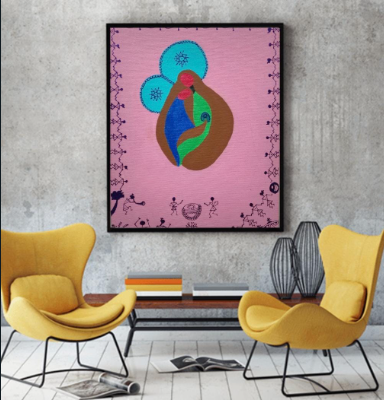My Store
The Divine Birth in Captivity -"Yashoda, Nandlal, and the Dawn of Shri Krishna
The Divine Birth in Captivity -"Yashoda, Nandlal, and the Dawn of Shri Krishna
 Order ON WHATSAPP
Order ON WHATSAPP
The Divine Birth in Captivity -"Yashoda, Nandlal, and the Dawn of Shri Krishna"
This evocative abstract painting captures the poignant moment of Lord Krishna's divine birth in a jail cell.
The central figures, representing Yashoda Maiya, King Nandlal, and the infant Krishna, are depicted in a stylized, symbolic form, nestled within a brown, encompassing shape that suggests both a protective embrace and the confines of their imprisonment.
Yashoda Maiya is represented by a nurturing, earthy brown, her form enveloping the vibrant blue of Nandlal and the tender green of the newborn Krishna. A touch of passionate red above symbolizes her maternal love and sacrifice. The figures are rendered with a flowing, organic quality, conveying the fluidity of divine presence amidst earthly constraints.
Above this central scene, two overlapping circles, one in a serene turquoise and the other in a luminous light blue, represent the divine aura surrounding the holy family.
These orbs radiate a sense of peace and transcendence, highlighting the spiritual significance of the event. The jail setting is alluded to by the brown shape capping the figures, suggesting the restrictive environment where this divine birth took place.
Framing this central scene is a border of traditional Warli art, depicting scenes of joyous celebration by the local villagers. These stick-figure-like representations of dance, music, and daily life contrast sharply with the central image of imprisonment, yet they also serve as a reminder of the hope and joy that Krishna's birth brings to the community.
This painting is a powerful representation of the divine birth of Lord Krishna in a jail cell, surrounded by the loving presence of Yashoda Maiya and King Nandlal. The brown shape, symbolizing the jail, does not confine the divine presence; rather, it becomes a testament to the triumph of good over evil, of hope over despair. The two circles representing the aura emphasize the spiritual significance of the event, while the Warli art border depicts the local celebration, highlighting the cultural context of the artwork.
This painting is a unique and deeply meaningful piece, an art that tells a story and evokes spiritual contemplation. It is telling the rich mythology of Lord Krishna and reflects the cultural heritage of India.
The juxtaposition of imprisonment and divine birth, of abstract representation and traditional folk art, makes this piece a compelling conversation starter and a source of inspiration.
AVYAKT1044
Share


